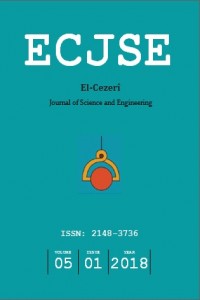Abstract
Endüstride taşlama işlemi için kullanılan çeşitli
özelliklerde birçok flap disk bulunmaktadır. Ancak bunların hemen hemen hepsi
standart kesitlerdeki yüzeyleri taşlama için tasarlanmıştır. Özel kesitli
profillerin taşlaması esnasında flap disklerin standart boyutlarından dolayı
taşlama operasyonunda zorluklar yaşanmaktadır. Flap diskin ulaşamadığı keskin
kesitler, taşlama esnasında bozulan radyuslar mevcuttur. Bu da hem ürün
kesitini bozabilmekte, hem de operasyonu yavaşlatmaktadır. Bu çalışmada, özel
kesitli profillerin taşlama işlemi için kesite uygun iki farklı flap disk
tasarımı yapılmıştır. Kesitte istenilen bölgeyi taşlayabilecek bir tasarım
olması gerektiği gibi, üretilebilirliği de göz önünde bulundurulması gerekmektedir.
Aynı zamanda tasarlanacak olan özel tasarım flap diski uygun şekilde kullanalabilecek
bir mekanizma gerekmektedir. Üç farklı tip flap disk (R5, 90º ve standart) kullanılmıştır.
Flap diskler ile işlenen yüzeylerin pürüzlülük değerleri taşınabilir yüzey
pürüzlülüğü ölçme cihazı ile belirlenmiş ve elde edilen sonuçlar
karşılaştırılmıştır.
Keywords
References
- Referans1 Demir, H., Güllü, A., 2008, Taş Dokusunun Yüzey Pürüzlülüğü ve Taşlama Kuvvetlerine Etkilerinin İncelenmesi, Gazi Üniv. Müh. Mim. Fak. Dergisi, 23 (1).
- Referans2 Srivastava, A. K., Yuen K. M., and Ebestavi M. A., 1992, Surface Finish in Robotic Disk Grinding, International Journal of Machine Tools and Manufacture, 32, 269-297.
- Referans3 Demir, H., Güllü, A., 2001, Taşlamada Parametrelerin Etkisi, Pamukkale Üniv. Müh. Bilimleri Dergisi, 7 (2), p.189-198.
- Referans4 J. Somgumnerd, V. Tangwarodomnukun, S. Prombanpong, "Effects of Flap Wheel Grinding Parameters on Surface Roughness for Stainless Steel", Applied Mechanics and Materials, Vols. 548-549, pp. 506-509, 2014.
- Referans5 Hettes, F. J.,1995, Flap disc abrasive tool, Weiler Brush Company Inc., Patent No: US 5752876 A.
- Referans6 Mosier, P., 2001, Abrasive Flap Disc, Limited, Elliott Industries, Patent No: US 6808446 B1.
- Referans7 Tang, J., Yin, F., Chen, X., 2013, The principle of profile modified face-gear grinding based on disk wheel, Mechanism and Machine Theory, 70, p.1-15.
- Referans8 Hettes,F.J., Mell, L.L., 1998, V-Shaped Flap Disc Abrasive Tool, Weiler Corporation, Patent No: US 6066034 A.
- Referans9 Gustav E., 2003, Flap disc, Vereinigte Schmirgel - und Maschinen-Fabriken AG, Patent No: US 6582289.
- Referans10 Güllü, A., Özdemir, A. ve Demir, H. 2003; Yüzey Pürüzlülüğü Ölçme Yöntemleri ve Mukayesesi, Teknoloji Dergisi, 6(1-2),79-92.
- Referans11 Demir, H., Güllü, A., 2008, Taş Sertliği ve İşleme Parametrelerinin Yüzey Pürüzlülüğü ve Taşlama Kuvvetlerine Etkilerinin İncelenmesi, Gazi Üniv.Mim. Fakültesi Dergisi, 23, 577-584.
- Referans12 Adıyaman,O., İkincil Dönel Eksenli ile Klasik Düzlem Yüzey Taşlama Mekanizmasında Kesme Parametrelerinin Yüzey Pürüzlülüğüne Etkisinin Deneysel İncelenmesi, Technological Applied Sciences (NWSATAS), 2A0092, 2016; 11(1): 10-23.
Abstract
In industry, flap discs
with various features are used for grinding. However, almost all are designed
for surface grinding with the standard sections. The grinding processes of
special cross-section profiles with standard flap discs are difficult due to
the fact that each flap discs have different physical dimensions. During the
grinding process, flap discs cannot reach to sharp cross-sections. The broken
radius during grinding frequently occurs. In this study, two different special
sections of the profile were designed and manufactured. Also, two tailor-made
grinding flap disc designs suitable for two different profiles were drawn and
produced. The purpose of this study is to obtain high quality production during
the grinding with special cross-section profiles to overcome difficulties in
grinding operations using the special sections of flap discs. Three types of
flap discs (R5, 90º and standard) were used. The roughness values of samples
ground were tested using a precision roughness tester. The results were
compared.
Keywords
References
- Referans1 Demir, H., Güllü, A., 2008, Taş Dokusunun Yüzey Pürüzlülüğü ve Taşlama Kuvvetlerine Etkilerinin İncelenmesi, Gazi Üniv. Müh. Mim. Fak. Dergisi, 23 (1).
- Referans2 Srivastava, A. K., Yuen K. M., and Ebestavi M. A., 1992, Surface Finish in Robotic Disk Grinding, International Journal of Machine Tools and Manufacture, 32, 269-297.
- Referans3 Demir, H., Güllü, A., 2001, Taşlamada Parametrelerin Etkisi, Pamukkale Üniv. Müh. Bilimleri Dergisi, 7 (2), p.189-198.
- Referans4 J. Somgumnerd, V. Tangwarodomnukun, S. Prombanpong, "Effects of Flap Wheel Grinding Parameters on Surface Roughness for Stainless Steel", Applied Mechanics and Materials, Vols. 548-549, pp. 506-509, 2014.
- Referans5 Hettes, F. J.,1995, Flap disc abrasive tool, Weiler Brush Company Inc., Patent No: US 5752876 A.
- Referans6 Mosier, P., 2001, Abrasive Flap Disc, Limited, Elliott Industries, Patent No: US 6808446 B1.
- Referans7 Tang, J., Yin, F., Chen, X., 2013, The principle of profile modified face-gear grinding based on disk wheel, Mechanism and Machine Theory, 70, p.1-15.
- Referans8 Hettes,F.J., Mell, L.L., 1998, V-Shaped Flap Disc Abrasive Tool, Weiler Corporation, Patent No: US 6066034 A.
- Referans9 Gustav E., 2003, Flap disc, Vereinigte Schmirgel - und Maschinen-Fabriken AG, Patent No: US 6582289.
- Referans10 Güllü, A., Özdemir, A. ve Demir, H. 2003; Yüzey Pürüzlülüğü Ölçme Yöntemleri ve Mukayesesi, Teknoloji Dergisi, 6(1-2),79-92.
- Referans11 Demir, H., Güllü, A., 2008, Taş Sertliği ve İşleme Parametrelerinin Yüzey Pürüzlülüğü ve Taşlama Kuvvetlerine Etkilerinin İncelenmesi, Gazi Üniv.Mim. Fakültesi Dergisi, 23, 577-584.
- Referans12 Adıyaman,O., İkincil Dönel Eksenli ile Klasik Düzlem Yüzey Taşlama Mekanizmasında Kesme Parametrelerinin Yüzey Pürüzlülüğüne Etkisinin Deneysel İncelenmesi, Technological Applied Sciences (NWSATAS), 2A0092, 2016; 11(1): 10-23.
Details
| Primary Language | Turkish |
|---|---|
| Subjects | Engineering |
| Journal Section | Makaleler |
| Authors | |
| Publication Date | January 31, 2018 |
| Submission Date | October 19, 2017 |
| Acceptance Date | October 26, 2017 |
| Published in Issue | Year 2018 Volume: 5 Issue: 1 |



